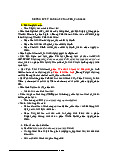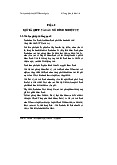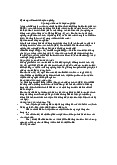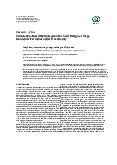















Preview text:
applied sciences Article
Thermodynamic Properties of Electrolyte Solutions, Derived
from Fluctuation Correlations: A Methodological Review Dimiter N. Petsev
Department of Chemical and Biological Engineering and Center for Micro-Engineered Materials,
University of New Mexico, Albuquerque, NM 87131, USA; dimiter@unm.edu
Abstract: This article presents a review of an approach for studying solution thermodynamics, which
is based the on hydrodynamic fluctuation correlations analysis method suggested by Landau and
Lifshitz. We show that the method is very general, and its applicability goes beyond hydrodynamics.
It starts with examining the entropy production and fluctuating transport fluxes, which are related to
concentration fluctuations and molecular interactions. The approach can be successfully applied to
compute a wide range of thermodynamic properties such as the osmotic pressure (i.e., equation of
state) and provides information about the interactions between the dissolved species. Using dilute
electrolyte solutions as a case study, we reproduce results from the Debye and Huckel theory while
starting from a very different physical perspective.
Keywords: fluctuations; electrolyte solutions; solution thermodynamics 1. Introduction
This paper offers an overview of the Landau and Lifshitz approach for the analysis Citation: Petsev, D.N.
of hydrodynamic fluctuations [1], and its potential to be used as a tool for obtaining Thermodynamic Properties of
meaningful and important physical results. The starting point for the analysis is the
Electrolyte Solutions, Derived from Fluctuation Correlations: A
fundamental law of entropy production, and therefore, its foundations are quite general.
Methodological Review. Appl. Sci.
The Landau and Lifshitz theory of hydrodynamic fluctuations is very helpful in studying
2022, 12, 5863. https://doi.org/
stochastic properties in viscous liquids. An intriguing example is the derivation of the 10.3390/app12125863
Stokes–Einstein diffusion coefficient by integrating the fluctuating viscous stresses acting
on the surface of a spherical particle, as demonstrated by Zwanzig [2] and later by Fox and
Academic Editors: Sérgio F. Sousa
Uhlenbeck [3]. The general approach can be extended beyond fluid momentum and heat and Andrea Atrei
transfer. It was used to offer a possible explanation for the attractive interactions between Received: 18 April 2022
like-charged particles in colloid crystals [4], the surface forces in thin liquid films due to Accepted: 6 June 2022
surface capillary waves [5], or ionic concentration-fluctuation correlations in electric double Published: 9 June 2022 layers [6].
The Landau and Lifshitz method can be adapted to examine the properties of solutions,
Publisher’s Note: MDPI stays neutral
including electrolytes. This was demonstrated by Donev et al. [7] and Peraud et al. [8],
with regard to jurisdictional claims in
who studied the fluctuations in such systems in detail. Their main focus was on the non-
published maps and institutional affil- iations.
equilibrium, gradient-driven transport in fluid mixtures and hence requires a numerical
approach. Still, they offered results for the equilibrium properties of solutions such as
structure factors and the corresponding radial distribution functions in the Debye and
Huckel limit. The focus of the present review is on the general analytical methodology
Copyright: © 2022 by the authors.
that allows for the derivation of thermodynamic equilibrium properties of electrolyte
Licensee MDPI, Basel, Switzerland.
solutions such as osmotic pressure, radial distribution functions, and interaction energies
This article is an open access article
between ions (potentials of mean force). The effect of the electrostatics enters the analysis
distributed under the terms and
via the Nernst–Planck equations [9] for the fluxes in combination with the Poisson equation
conditions of the Creative Commons
that relates the electrostatic potential to the charge in the fluid [10]. We provide a detailed
Attribution (CC BY) license (https://
pathway for deriving the Debye and Huckel mean field theory of strong electrolytes [11,12]),
creativecommons.org/licenses/by/
starting from the general relationship for the entropy production. All assumptions are 4.0/).
Appl. Sci. 2022, 12, 5863. https://doi.org/10.3390/app12125863
https://www.mdpi.com/journal/applsci
Appl. Sci. 2022, 12, 5863 2 of 16
clearly outlined, which helps to better understand the limitations of the Debye and Huckel
model. This analysis is less general than the one offered by Peraud et al. [8], as it does not
include non-equilibrium effects. Abandoning some of the simplifications (dilute solutions,
small fluctuation amplitudes, solvent structural molecular contributions, etc.) may in
principle lead to a more general theory. The complexity of the calculations, however, would
increase and obtaining analytical results may again become impossible. 2. Theoretical Approach
In this section, we present a brief overview of the Landau and Lifshitz description of
fluctuating hydrodynamics [1] and outline the application of the general method to other
transport processes such as mass diffusion. The latter is necessary in order to examine
the concentration fluctuations, which will next be used to determine the thermodynamic properties of solutions.
2.1. Entropy Production and Fluxes
We start with examining the entropy production rate in the solution, S (i.e., its change
with time, t), which is given by [1,13] dS d d = iS + eS . (1) dt dt dt
The first term on the right-hand side is due to irreversible processes inside the thermo-
dynamic system and according to the second law of thermodynamics is always positive, or
diS/dt ≥ 0. The second term accounts for the entropy change that results from exchanges
of energy and matter with the systems surroundings. It is the irreversible part of the
total entropy charge that is relevant to the current discussion. In the case of a solution, it reads [1,13] 1 d ˙ Z i S S ∇µ = = − dV i · , (2) kB dt kB ∆V kBT
where i is the diffusion flux in kg m−2s−1, µ is the chemical potential, and ∆V is some
volume within the solution. If the volume ∆V is small, Equation (2) becomes ˙ S ∇µ ≈ −i · ∆V, (3) kB kBT
Following Landau and Lifshitz [1], we can write Equation (2) (or Equation (3)) in the form ! Z ˙S =
dV ∑ Xη ˙xη
≈ ∑ Xη ˙xηδV. (4) ∆V η η
The quantities Xη and ˙xη are the generalized thermodynamic forces and fluxes, respec-
tively [1,13,14]. Comparing Equation (4) to (2) leads to 1 ∂µ Xη = , ˙x k η = iη (5) B T ∂rη
where we have set µ = µ1/m1 − µ2/m2. The index η = 1, 2, 3 accounts for the three spatial
coordinates r1, r2, r3. The total flux can then be expressed as
i = −α∇µ + δi, (6)
where δi is the fluctuating part of the flux i.
Appl. Sci. 2022, 12, 5863 3 of 16
2.2. Correlation of the Fluctuating Diffusion Fluxes
The generalized fluxes can formally be expressed by [1,14] ˙
xη = − ∑ γηζ Xζ + yη. (7) ζ
The indices η and ζ correspond to various transport processes in all three spatial
directions that may be present in the solution, where the fluctuating fluxes correlations are given by [14,15] hyη(t ) (
1 yζ t2)i = (γη ζ + γζη )δ(t1 − t2). (8)
The angular brackets h. . . i denote ensemble averaging [12,14]. Note that hyη(t ) 1 i = 0.
We can write the η-component of Equation (6) in the form αk 1 ∂µ i B T η = − ∑ δ ∆V + δi ∆V ηζ k ∂r η (9) ζ B T ζ
A comparison of Equation (9) with Equation (7) leads to the following expressions for
the coefficient γηζ and the fluctuating flux δiη αk γ B T ηζ = δ
∆V ηζ, yη = δiη, (10)
where again δiη denotes the fluctuation of the η component of the mass flux. The symbol δηζ
is the Kronecker delta [16]. Combining Equations (7)–(10) and noting that γηζ = γζη [15] allows obtaining 2αk hδi B T η (r )
1, t1 δiζ (r2, t2)i = δ ∆V
ηζ δ(t1 − t2). (11)
Taking the limit ∆V → 0 transforms Equation (11) into hδiη(r ) ( )
1, t1 δiζ r2, t2 i = 2αkB Tδηζ δ(t1 − t2)δ(r1 − r2). (12)
Let us consider a two-component system where component 1 is the solute and compo-
nent 2 is the solvent. The fundamental thermodynamic equation for the internal energy E reads [12,14]
dE = TdS − pdV + µ1dN1 + µ2dN2 (13)
where T is temperature, p is pressure, V is volume and N1 and N2 are the number of
molecules of type 1 and 2. The chemical potentials of the solute and solvent read
µ1 = µ01 + kBT ln N1, and µ2 = µ02 + kBT ln N2. (14)
If the corresponding molecular masses are m1 and m2, then we can write total mass as
Mt = N1m1 + N2m2 (15)
Combining Equations (13) and (15), and introducing a new variable c = N1m1, leads to µ µ
dE = TdS − pdV + 1 − 2 dc. (16) m1 m2
The diffusion coefficient for component 1 is defined as α ∂µ αV ∂µ D = = , (17) ρ ∂n1 m1 ∂N1
Appl. Sci. 2022, 12, 5863 4 of 16
where ρ is the solution density (see Equations (13) and (16)) N ρ =
1m1 + N2m2 (18) V
and n1 is the mass fraction of component 1, or N n 1m1 1 = (19)
N1m1 + N2m2
Assuming n1 ≪ 1 (or N1 ≪ Nt , where Nt is the total number of molecules), and taking
the derivative of the combined chemical potential µ = µ1/m1 − µ2/m2 with respect to N1 leads to αV ∂ µ µ α k k αk D = 1 − 2 = B T + B T ≈ B T (20)
m1 ∂N1 m1 m2 ρ m1N1
m2(Nt − N1) m2c 1 1
where c1 = N1/V is the number concentration of component 1. Solving for α results in m2c α = 1 1 D . (21) kBT
It is helpful to introduce fluctuation fluxes per unit mass as δj = δi/m1 and δjη =
δiη/m1. Replacing Equation (21) in Equation (12) yields hδjη(r ) (
1, t1 δjζ r2, t2)i = 2cDδηζ δ(t1 − t2)δ(r1 − r2) (22) or in tensor form hδj(r ) ( )
1, t1 δj r2, t2 i = 2cDIδ(t1 − t2)δ(r1 − r2), (23)
with I being the unit tensor with elements δηζ . Equations (22) and (23) imply that only
the fluxes of the same species are correlated. The correlation of fluxes of different species is zero.
3. Fluctuation Correlations and Thermodynamics of Binary Symmetric Electrolyte Solutions
A binary electrolyte solution is actually a ternary system that consists of positive ions,
negative ions, and solvent. However, if the concentrations of both positive and negative ions
(c+ and c−) is low in comparison to that of the solvent c, then each ionic species presents an
ideal solution, and all results from the previous section are applicable to each of them. Our
analysis focuses on symmetric electrolytes where the ions carry the same charge numbers,
z, but with opposite signs. The presence of the charges in the solution, however, creates an
additional difficulty associated with the electric fields and electrostatic interactions between
the charged components. The celebrated theory of Debye and Huckel [11 ] was the first
successful attempt to overcome these difficulties and is still included in most texts that are
dedicated to the physics and chemistry of electrolyte solutions. The fluctuation correlation
analysis, described here, offers a different starting point to approach the same problem.
It reveals some important physical insights and provides strategies for solving similar
problems in a relatively straightforward way.
Appl. Sci. 2022, 12, 5863 5 of 16 3.1. Balance Equations
We start with balancing the mass of dissolved electrolytes as well as the potential in
the solution. The mass balance Nernst–Planck equations read
∂c+ = −∇ · j+ + zeβ+∇ · (c+∇ψ) ∂t (24)
∂c− = −∇ · j
∇ · (c ∇ψ). ∂t − − zeβ− −
The coefficients β+ and β− are the hydrodynamic mobilities of the positive and
negative ions, while e is the elementary charge. The electrostatic potential ψ is related to
the charge density ρe = ze(c+ − c−) by means of the Poisson equation [10] ρ ∇2ψ = − e , (25) εε0
where ε0 is the dielectric constant in vacuo, and ε is the relative dielectric permittivity.
In order to account for the fluctuations in the solution, we define the fluxes, the
concentrations, and the local potential as
j+ = −D+∇c+ + δj+ (26)
j− = −D−∇c− + δj−,
c+ = c + δc+ (27)
c− = c + δc−, and ψ = 0 + δψ, (28)
where D+ = kBT/β+ and D− = kBT/β− are the diffusion coefficients for the positive and
negative ions, δc+ and δc− are the concentration fluctuations for the positive and negative
ions, and c is the uniform average concentration in units of number per volume. The
resultant local electrostatic potential fluctuation is δψ.
The balance equations for all fluctuating quantities become
∂δc+ = ∇2δc+ − ∇δ · j+ + zeβ+c∇2δψ ∂t (29)
∂δc− = ∇2δc ∂t
− − ∇δ · j− − zeβ−c∇2δψ. δρ
∇2δψ = − e , (30) εε0 The charge fluctuation is
δρe = ze(δc+ − δc δρ δρ −) = + + −, (31) where
δρ+ = zeδc+, and δρ− = −zeδc−. (32)
Rearranging the above equations yields ∂δρ + κ2 = D ∇2δρ δρ
− ze∇ · δj ∂t + + − + 2 e ∂δρ − κ2 = D ∇2δρ δρ
+ ze∇ · δj (33) ∂t − − − 2 e −, 2z2e2c 2z2e2cβ 2z2e2cβ κ2 = = + = − . εε0kBT εε0D+ εε0D−
Appl. Sci. 2022, 12, 5863 6 of 16
The parameter κ is the Debye screening parameter (inverse length) [11], which is a
measure of potential magnitude reduction with distance around an ion in the solution.
A significant simplification of Equation (33) can be achieved by setting D+ = D− = D,
and noting that for symmetric electrolytes, the overall concentrations are c+ = c− = c.
This seems like a very strong limitation, but it does not affect the majority of the final
results. Combining the first two equations in (33) leads to an equation for the charge density fluctuation ∂δρe = D ∇2δρ
− ze∇ · (δj+ − δj ∂t
e − κ2δρe −). (34)
3.2. Charge Fluctuation Correlations and Correlation Energy
We will use the Fourier transform technique [16] to express the charge and flux fluctuations as 1 Z ∞ Z ∞ δ ˆ
ρe(k, ω) = dr dtρ (2π)2
e(r, t)ei(ωt−k·r) (35) −∞ −∞ and 1 Z ∞ Z ∞
δˆj(k, ω) = dr
dtδj(r, t)ei(ωt−k·r). (36) (2π)2 −∞ −∞ The inverse transforms are 1 Z ∞ Z ∞
δρe(r, t) = dk dω ˆρ (2π)2
e(k, ω)e−i(ωt−k·r) (37) −∞ −∞ and 1 Z ∞ Z ∞
δj(r, t) = dk
dωδˆj(k, ω)e−i(ωt−k·r) (38) (2π)2 −∞ −∞
where k is the wavevector and ω is the frequency.
The ionic fluxes and their correlations are of special interest. For low ionic concen-
trations, the diffusion flux of each component does not depend on any variable pertinent
to the other solutes (see Equations (20)). Hence, the correlations between the fluxes for different species is zero, or hδj+(r ) ( )
1, t1 δj+ r2, t2 i = 2cDIδ(t1 − t2)δ(r1 − r2), hδj−(r )
1, t1 δj−(r )
2, t2 i = 2cDIδ(t1 − t2)δ(r1 − r2), (39) hδj+(r )
1, t1 δj−(r )
2, t2 i = hδj−(r ) )
1, t1 δj+(r2, t2 i = 0.
Equations (38) and(39) allow for the derivation of the important relationship (see Appendix A)
hδˆj(k1, ω1)δˆj(k2, ω2)i = 2cIDδ(ω1 + ω2)δ(k1 + k2). (40)
Note that the right-hand sides for the first two equations in (40) are the same irrespec-
tive of whether the positive or negative ionic fluxes are correlated.
Equations (35)–(38) allow Fourier transforming the whole Equation (34)
iωδ ˆρe(k, ω) = −D(k2 + κ2)δ ˆ
ρe(k, ω) + izek · [δˆj+(k, ω) − δˆj−(k, ω)]. (41)
Solving for the charge density δ ˆ
ρe(k, ω) yields
ikze[δˆj δ ˆρ
+(k, ω) − δˆj−(k, ω)]
e(k, ω) = . (42)
iω + D(k2 + κ2)
Appl. Sci. 2022, 12, 5863 7 of 16
The charge correlation fluctuation correlation is
hδ ˆρe(k1, ω1)δ ˆρe(k2, ω2)i = k (43)
− 1 · (ze)2[hδˆj+(k1, ω1)δˆj+(k2, ω2)i + hδˆj−(k1, ω1)δˆj−(k2, ω2)i] · k2 .
[iω1 + D(k2 + κ2)][iω + κ2)] 1 2 + D(k2 2
Using Equations (40) and (43), the identity k1 · I · k2 = k1 · k2 leads to 4(ze)2cDk ( h
1 · k2δ ω1 + ω2)δ(k1 + k2)
δ ˆρe(k1, ω1)δ ˆρe(k2, ω2)i = − . (44)
[iω1 + D(k2 + κ2)][iω + 1 2 + D(k2 κ2)] 2
The electrostatic energy per unit volume of the solution is (see Figure 1) Ee 1 = hδψ(r V 2
1, t1)δρe(r2, t2)i. (45)
Using the Fourier transform of Equation (30) δ ˆρ 1 δ ˆρ − k2 e e 1δ ˆ ψ = − or δ ˆ ψ = (46) εε0 k2 εε 1 0
Then, the correlation of the potential and charge fluctuations in Equation (45) becomes (see also Equation (43)).
Figure 1. The correlation energy (50) is due to the interaction of the chargeδρe with the potential δψ . 4(ze)2cDk
hδ ˆψ(k
1 · k2δ(ω1 + ω2)δ(k1 + k2) 1, ω1)δ ˆ
ρe(k2, ω2)i = − . (47)
εε0k2[iω + κ2)][iω + 1 1 + D(k21 2 + D(k2 κ2)] 2
Assuming t1 = t2 = t, and inverting (47) with respect to ω1 and k1 (see Appendix B)
leads to the following result for the electrostatic energy (45) Ee k e−κr = BTκ2 (48) V 8π r
Appl. Sci. 2022, 12, 5863 8 of 16
Expanding the exponential leads to Ee k 1 k k
= BTκ2 ( − κ + . . . ) ≈ BTκ2 − BTκ3 (49) V 8π r 8πr 8π
The first term on the right-hand side is the self-energy of the ions, while the second
term accounts for the electrostatic correlation energy [14] Ecorr k = − BTκ3 (50) V 8π
3.3. Thermodynamic Relationships
3.3.1. Free Energy and Chemical Potential
The focus of this section is on the effect of electrolyte solution non-ideality, which is
represented by the correlation energy (50) , on its thermodynamic properties. We start with
the general thermodynamic relationship between the internal energy Eand the Helmholtz free energy A [12,14] E ∂ A = − (51) T2 ∂T T V
Substituting the correlation internal energy (50) into the above equation and integrat-
ing over the temperature yields
(ze)3V 2c 3/2 N A − A e id = − √ , c = (52) 12π kBT εε0 V
Let Ne be the number of pairs of positive and negative ions, and Nw is the total number
of water molecules. Since we are considering a dilute electrolyte solution, it is reasonable
to assume that the total volume is V ≈ Nwvw, where vw is the molecular volume of water. Then, Equation (52) becomes (ze)3(2N A − A e)3/2 id = − √ √ . (53)
3 2π kBT(Nwvw)1/2(εε0)3/2
Differentiating Equation (53) with respect to Nw allows obtaining the chemical poten-
tial of the solvent (i.e., the water) " # ∂A ∂A ∂ (ze)3(2Ne)3/2 µ id w = − = − √ √ . (54) ∂Nw N ∂N ∂Nw )1/2( e w Ne 3 2π kBT(Nwvw εε0)3/2
After some rearrangements, we finally obtain kBTvwκ3 µw − µid w = (55) 24π
where µw is the total chemical potential and µidw is the ideal part defined by [12,14] N w µid w = µ0
w + pvw + kB T ln . (56) Nw + 2Ne
µ0w is the standard chemical potential.
Appl. Sci. 2022, 12, 5863 9 of 16 3.3.2. Osmotic Pressure
The osmotic pressure difference between the electrolyte solution and the pure water
solvent can be derived from the chemical equilibrium relationship N k µ0 w B Tvwκ3
w + p0vw = µ0
w + pvw + kB T ln + (57) Nw + 2Ne 24π Rearranging (57) yields k 2N k
∆p = p − p B T e B Tκ3 0 = − ln 1 − − (58) vw Nw + 2Ne 24π
where ∆p is the osmotic pressure of the electrolyte solution. For dilute electrolytes,
2Ne/(Nw + 2Ne) ≪ 1 and (58) simplifies to k 2N k
∆p = p − p B T e B Tκ3 0 ≈ − vw Nw + 2Ne 24π (59) 2N k k ≈k e B Tκ3 B Tκ3 B T − = 2ck . N B T − wvw 24π 24π
The first term on the right-hand side of Equation(59) corresponds to the ideal part of
the solution osmotic pressure, while the second term accounts for the charge correlation
effects. This result for the osmotic pressure also follows from the traditional Debye–Huckel approach [12,14].
3.3.3. Radial Distribution Functions and Pair Interaction Energies
The starting point for determining the radial distribution functions are the concentration-
fluctuation correlation functions hδcmr+, t)δcn(r+ , t)i,
hδcmr−,t)δcn(r− , t)i, and
hδcmr+, t)δcn(r−, t)i, where the indices + and − correspond to the two ionic species (posi-
tive and negative) in the solution. Combining Equations (29) and (30) leads to ∂δc+ κ = D ∇2δc
δρe − ∇ · δj+ ∂t + − 2ze (60) ∂δc− κ = D ∇2δc
δρe − ∇ · δj ∂t − + 2ze −.
Transforming Equation (60) and solving for the concentration fluctuation yields
ik · δˆj+(k, ω) Dκ2 δ ˆ
ρe(k, ω)
δ ˆc+(k, ω) = − iω + Dk2
2ze (iω + Dk2) (61)
ik · δˆj Dκ2 δ ˆ
ρe(k, ω) δ ˆc −(k, ω) −(k, ω) = + iω + Dk2
2ze (iω + Dk2)
Equation (61)can be used to find the Fourier transform if the concentration-fluctuations
correlations for positive–positive negative–negative and positive–negative ionic combina-
tions. These are then used to obtain the radial distribution functions and the potentials of
mean force for all ionic interactions in the mean field (i.e., Debye–Huckel) limit (see also Ref. [8]).
Appl. Sci. 2022, 12, 5863 10 of 16
3.4. Positive–Positive Ionic Correlations
The Fourier transform of the positive–positive ions concentrations fluctuation correla-
tion is derived from the first Equation (61). After averaging, the result is
hδ ˆc+(k1, ω1)δ ˆ
c+(k2, ω2)i = k
D2κ4 hδ ˆρ
− 1 · hδˆj+(k1, ω1)δˆj+(k2, ω2)i · k2 +
e(k1, ω1)δ ˆ
ρe(k2, ω2)
(iω1 + Dk2)(iω ) 4(ze)2 (iω )(iω ) 1 2 + Dk22 1 + Dk21 2 + Dk2 2 (62) " # Dκ2 ik ik − 1 · hδˆ
j+(k1, ω1)δ ˆρe(k2, ω2)i + 2 · hδˆj+(k2, ω2)δ ˆρe(k1, ω1)i , 2ze
(iω1 + Dk2 )(iω ) )(iω 1 2 + Dk2 (iω ) 2 1 + Dk21 2 + Dk2 2
Inverting Equation (62) (see Appendices B and C) and setting t1 = t2 = t leads to the
following result for the concentration-fluctuation correlation in real space
hδc+r1, t)δc+(r )
2, t i = cδ(r1 − r2) + c2[g++ (r) − 1]. (63) where (ze)2 e−κr g++(r) = 1 − (64) 4πεε0kBT r
is the radial distribution function for the positive ions. Comparing (64) to the formal definition w++(r) w g ++ (r) ++ (r) = e− kBT ≈ 1 − (65) kBT
leads to the Debye and Huckel [11] result for the electrostatic energy of interaction between the ions in the solution
(ze)2 e−κr
w++(r) = zeψ(r) = . (66) 4πεε0 r
The energy is positive, which indicates a repulsive interaction.
3.5. Negative–Negative Ionic Correlations
Using the second Equation (61), we obtain the concentration negative–negative ion
concentration-fluctuation correlation in the form
hδ ˆc−(k1, ω1)δ ˆ
c−(k2, ω2)i = k
D2κ4 hδ ˆρ
− 1 · hδˆj−(k1, ω1)δˆj−(k2, ω2)i · k2 +
e(k1, ω1)δ ˆ
ρe(k2, ω2)
(iω1 + Dk2)(iω ) 4(ze)2 (iω )(iω ) 1 2 + Dk22 1 + Dk21 2 + Dk2 2 (67) " # Dκ2 ik ik + 1 · hδˆ
j−(k1, ω1)δ ˆρe(k2, ω2)i + 2 · hδˆj−(k2, ω2)δ ˆρe(k1, ω1)i . 2ze
(iω1 + Dk2 )(iω ) )(iω 1 2 + Dk2 (iω ) 2 1 + Dk21 2 + Dk2 2
Note that the sign in front of the last two terms on the right is positive, which is
in contrast to Equation (62). Following the same recipe as for the positive–positive ion
interactions above (see Appendix C), we derive hδc−(r ) 1, t δc−(r )
2, t i = cδ(r1 − r2) + c2[g−− (r) − 1]. (68)
The radial distribution function is (ze)2 e−κr
g−−(r) = 1 − , (69) 4πεε0kBT r
and the interaction energy reads [11]
(ze)2 e−κr w−−(r) = , (70) 4πεε0 r
Appl. Sci. 2022, 12, 5863 11 of 16
which is also positive (i.e., repulsive). Hence, the radial distribution functions and interac-
tion energies for ions that are both positive or both negative are identical.
3.6. Positive–Negative Ionic Correlations
The positive–negative ion concentration-fluctuation correlation is also derived from
Equation (61). The result becomes
D2κ4 hδ ˆρ hδ ˆc
e(k1, ω1)δ ˆ
ρe(k2, ω2)
+(k1, ω1)δ ˆ
c−(k2, ω2)i = − 4(ze)2 (iω1 + Dk2)(iω ) 1 2 + Dk22 " (71) # Dκ2 ik ik + 1 · hδˆ
j+(k1, ω1)δ ˆρe(k2, ω2)i − 2 · hδˆj−(k2,ω2)δˆρe(k1,ω1)i . 2ze
(iω1 + Dk2 )(iω ) (iω )(iω ) 1 2 + Dk2 2 1 + Dk21 2 + Dk2 2
The correlation between the positive and negative ionic fluxes is zero because of
Equation (39). In addition, hδ ˆc+(k1, ω1)δ ˆc−(k2, ω2)i = hδ ˆc−(k1, ω1)δ ˆc+(k2, ω2)i. The
inversion of Equation (71) at t1 = t2 = t yields hδc+(r ) 1, t δc−(r )
1, t i = c2[g+−(r) − 1]. (72)
The radial distribution function and pair interaction energy between oppositely charged ions are (ze)2 e−κr g+−(r) = 1 + , (73) 4πεε0kBT r and [11]
(ze)2 e−κr w+−(r) = − . (74) 4πεε0 r
The sign of the interaction energy w+−(r) is negative, which is in agreement with the
fact that positive and negative ions attract each other. 4. Conclusions
The Landau–Lifshitz approach for the treatment of hydrodynamic fluctuations is
based on the fundamental expression for entropy production (4). Its generalization to
include transport processes (such as diffusion) is straightforward. The method offers
simple expressions for the correlation of the fluctuating fluxes. The flux fluctuations are
related to the concentration fluctuations, which in turn account for the effects of interactions.
Proper averaging allows us to derive results that are pertinent to systems in thermodynamic
equilibrium. The procedure is relatively simple, and the main mathematical techniques
are the forward and inverse Fourier transforms, and more specifically the transforms of various Dirac delta functions.
The focus of this paper is on electrolyte solutions. We show how the Landau and
Lifshitz method can be used to derive the Debye and Huckel theory of strong, dilute
electrolytes. This is accomplished without formally solving the Poisson equation of electro-
statics (25). Even the Debye and Huckel assumption of low potential and the subsequent
linearization of the Boltzmann distribution of the local charge ρ(r) zeψ(r) 2(ze)2c − = 2zec sinh ≈
ψ = κ2ψ (75) ǫǫ0 kBT ǫǫ0kBT
is not explicitly applied. Instead, we use the relationship between charge and potential
fluctuations (30) to write the transport Equation (29) in terms of concentration fluctuations.
The equilibrium state, in our analysis, is established by the integration (averaging) over
the entire frequency spectrum in Fourier space. The assumptions δc+ ≪ c, δc− ≪ c,
δρe ≪ ρe, and δψ ≪ ψ are equivalent to the Debye and Huckel low potential approximation
zeψ(r)/kBT < 1. However, the fluctuation correlation analysis clearly demonstrates that
the low potential approximation is implied by the small charge density fluctuations, which




